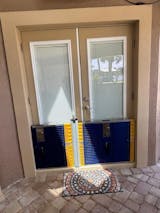Purchasing a home is a major life event, a serious undertaking with enormous financial ramifications. Saving for a down payment, getting a mortgage pre-approval, and closing on a home typically requires tightening the purse strings. Margins for error are usually low, whether you're meticulous in ensuring you're ready to buy your first home or splurging on a vacation property. With this in mind, it's in your best interest as a homebuyer to minimize the potential for unexpected expenses such as dealing with flooding.
Taking proactive steps to prevent or minimize damage from extreme weather is one of the best things homeowners can do to ensure their financial security, especially early on in homeownership. Depending on your home's location and the time of year, flooding is one of the biggest threats to your home, and the damage it can cause is exceptionally costly. Thankfully, there are several things that you can do to defend against flooding, and grading your lawn away from your home's foundation is the most significant and straightforward of them.
What Grading is and Why it's Important
Grading, also known as sloping, is the process of changing the elevation of your property so that water flows away from structures like your home. This is done by excavating soil from high points on your property and using it to fill in lower areas. The end result should be a slope that starts at your home's foundation and gradually slopes down and away.
There are two primary reasons why grading is essential for preventing flooding. First, redirecting water flow away from your home lessens the chances of water seeping into your basement or crawlspace. The second is that proper grading can also help to prevent runoff, which is when rainwater collects on your property and then flows toward your home in large quantities. Runoff is a serious problem because it can cause extensive damage very quickly, so it's crucial to do everything you can to prevent it.

Unfortunately, many homes are not properly graded, which puts them at an increased risk of flooding. If your home is one of these, don't worry—it's not too late to take action. You can grade your lawn yourself or hire a professional to do it for you.
How to Grade Your Lawn Yourself
If you're going to grade your lawn yourself, the first step is to assess the current state of your property. You'll need to look at the slope of your lawn and identify any areas where water might pool. Once you've done that, you can start making a plan for how to change the grade.
The best way to grade your lawn is with a power tiller. This will make the job much easier and will allow you to make precise changes to the grade. If you don't have a power tiller, you can rent one from a home improvement store or borrow one from a friend or neighbor.
Once you have your equipment, you're ready to start grading. Begin by tilling the soil around the perimeter of your home. You'll want to make sure that the soil is loose enough to move easily. Next, use your tiller to create a slope that starts at your home's foundation and gradually slopes down and away from it.
As you work, be mindful of any existing plants on your property. Try to avoid disturbing their roots as much as possible. Once you've finished grading, you can replant any uprooted plants or seed the area with grass seed. It's also a good idea to add some mulch to the area. This will help to hold the soil in place and prevent erosion.
Keep Your Lawn Well-Manicured and Free of Debris
Once you've finished grading your lawn, it's important to keep it well-manicured. This means regularly mowing the grass and removing any debris that might collect on your property. Debris can impede water flow and cause pooling, so it's crucial to get rid of it as soon as possible.

You should also make sure to clean your gutters and downspouts regularly. Clogged gutters can cause runoff, so it's important to keep them clear of debris.
Tips for Preventing Flooding in Your Home
Grading your lawn is an important step in preventing flooding, but it's not the only thing you can do. Here are a few additional tips to help keep your home safe from floodwaters:
-
Install a sump pump in your basement or crawlspace. This will help to remove any water that does manage to get inside.
-
Make sure your gutters and downspouts are clean and in good repair.
-
Stay up-to-date on the weather forecast and be prepared to take action if a storm is headed your way.
-
Keep an emergency kit on hand in case you need to evacuate.
Conclusion
Grading your lawn is an important part of preventing flooding. By redirecting water flow away from your home, you can lessen the chances of water damage—and reduce the risk of facing the long flood recovery process. Be sure to keep your lawn well-manicured and free of debris, and take other precautions like installing a sump pump and staying up-to-date on the weather forecast. Taking these steps will help to keep your home safe from floodwaters.
$949.00
DAM EASY® FLOOD GATE - DOOR DAM Floods are becoming more common around the world. What was once a 100-year phenomenon is now a seasonal trend that homeowners must deal with. That’s EXACTLY why you need this Dam Easy Flood… Read MoreFlood Barrier Door Dam - Ultimate Flood Gate




















